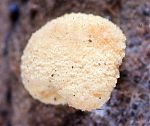Modicella
MODICELLA Kanouse, 1936 (Mycologia 28: 60); 2 species (Benny et al., 1987; Gerdemann and Trappe, 1974; Thaxter, 1922 [as Endogone species]).
Sporocarps composed of sporangia and hyphae, epi- or hypogeous; producing a garlic-like odor. Sporangia more or less globose to ovoid; columella septum-like, formed at the apex of nutritive hypha; multispored. Sporangiospores ellipsoid, hyaline, smooth walled.
Type species: M. malleola
Species of Modicella:
M. malleola (Harkness) Gerdemann & Trappe, 1974 (Mycologia mémoire 5:67) (Benny et al., 1987; Gerdemann and Trappe, 1974; Wu and Chen, 1986).
= Endogone malleola Harkness, 1899 (Proc. Cal. Acad. Sci. Ser. 3, 1:280) (Thaxter, 1922; Walker, 1923).
= Endogone torrendii Bresadola, 1913 (in Torrend, Broteria 11:101) fide Thaxter (1922).
M. reniformis (Bresadola) Gerdemann & Trappe, 1974 (Mycologia mémoire 5:68) (Benny et al., 1987).
= Endogone reniformis Bresadola, 1896 (Hedwigia 35:297) (Thaxter, 1922 ).
= Endogone argentina Spegazinni, 1899 (An. Mus. Nac. Buenos Aires 6:300) fide Thaxter (1922).
Two species of Modicella have been described. Modicella reniformis (as Endogone reniformis) is known only in southern South America (Thaxter, 1922). Modicella malleola (as E. malleola) has been collected in Europe, New Zealand, several places in the United States (Thaxter, 1922), and Taiwan (Wu and Chen, 1986). Gerdemann and Trappe (1974) transferred E. malleola and E. reniformis to Modicella, and they noted that fresh sporocarps of M. malleola produced an onion-like (garlic-like?) odor. Trappe and Schenck (1982) transferred Modicella to the Mortierellaceae. Although widely distributed, M. malleola is seldom reported in the literature. Fresh material of M. malleola needs to be collected and sequenced so that it true affinities can be ascertained.
Bibliography
Benny, G.L., J.L. Gibson, and J.W. Kimbrough. 1987. The taxonomic position of Modicella, p. 311. In: D.M. Sylvia, L.L. Hung, and J.H. Graham (eds.). Mycorrhizae in the next decade. Practical appications and research priorities. Institute of Food and Agricultural Sciences, University of Florida, Gainesville.
Gerdemann, J. W., and J. M. Trappe. 1974. The Endogonaceae in the Pacific northwest. Mycologia Mem. 5:1-76.
Kanouse, B.B. 1936. Studies of two species of Endogone in culture. Mycologia 28:47-62.
Thaxter, R. 1922. A revision of the Endogoneae. Proc. Amer. Acad. Arts Sci. 57:291-351.
Trappe, J.M., and N.C. Schenck. 1982. Taxonomy of the fungi forming endomycorrhizae. A. Vesicular-arbuscular mycorrhizal fungi (Endogonales, Pp. 1-9. In: N.C. Schenck (Ed.). Methods and principles of mycorrhizal research. APS Press, St. Paul, Minnesota.
Walker, L.B. 1923. Some observations on the development of Endogone malleola Hark. Mycologia 15:245-257.
Wu, C.-g., and Z.-c. Chen. 1986. The Endogonaceae of Taiwan I. A preliminary investigation on Endogonaceae of bamboo vegetation at Chi-Tou areas, central Taiwan. Taiwania 31:65-88.
Updated Mar 06, 2007

